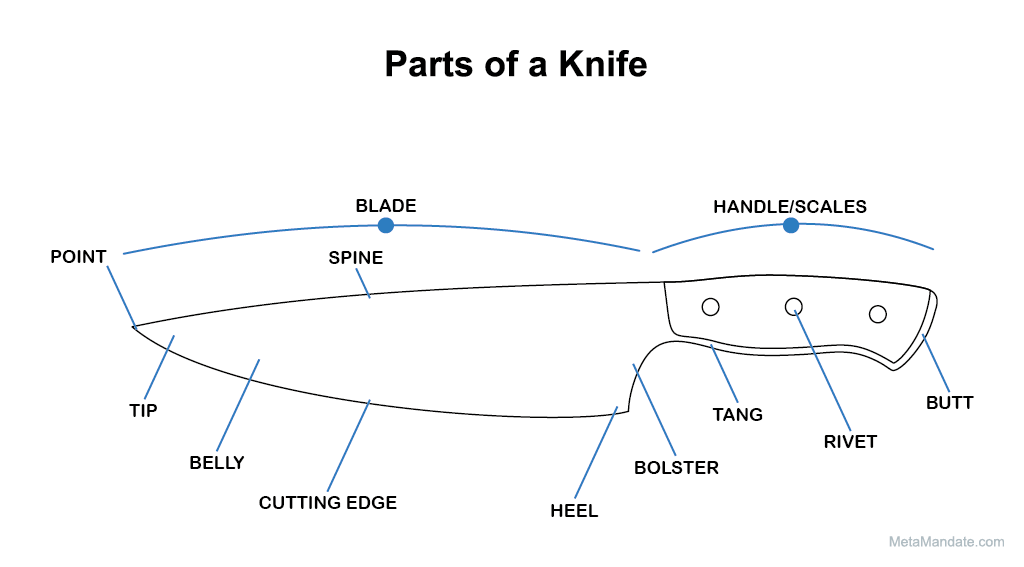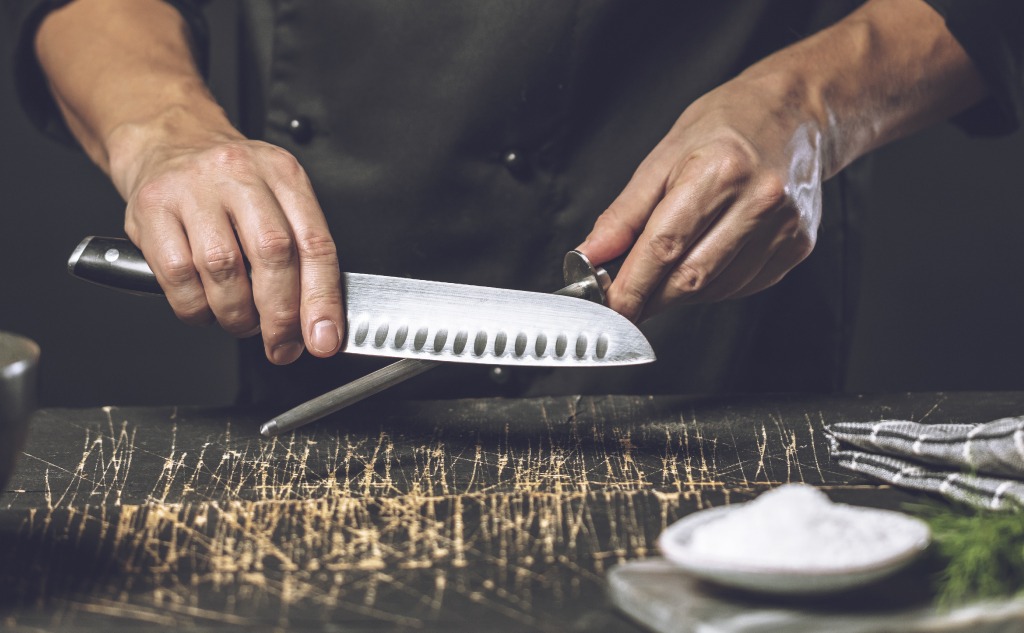Here are the 7 parts of a knife:
- Blade
- Point
- Tip (Belly)
- Edge
- Heel
- Spine
- Bolster
- Handle (Scales)
- Tang
- Rivets (Handle Fasteners)
- Butt (Pommel)
So if you want to learn all about the parts of a knife, their names, and their functions, then you’re in the right place.
Let’s jump right in!
Table of Contents
- #1 Blade
- #2 Point
- #3 Tip (Belly)
- #4 Edge
- #5 Heel
- #6 Spine
- #7 Bolster
- #8 Handle (Scales)
- #9 Tang
- #10 Rivets (Handle Fasteners)
- #11 Butt (Pommel)

#1 Blade
The blade is the main component of a knife. At first glance, a blade may seem deceptively simple. However, blades come in all shapes and forms.
The knife you’re picturing right now probably has a straight-edged blade. This is the most common type of blade. It’s sharp and versatile, acting as an all-rounder around the kitchen.
Different blades have different uses, though. For example, if you want to effortlessly cut steak, you’re going to need a serrated blade. Serrated blades are one of the toughest types of knives. The rough edges enable it to cut through the meat fibers without breaking a sweat.
If you’re looking to cut bread, you’ll have to go with a scalloped blade. Scalloped blades are similar to serrated blades but the edges are wider and joined together by arches. This enables the blade to make clean cuts in bread, and can also be used on other unyielding surfaces, like briskets.
Other types of blades include hollow ground blades for delicate cuts and Granton edge blades for carving and slicing.
Regardless of the type of knife, all blades have a point, tip, edge, and heel. Let’s take a closer look.
#2 Point
The point of the knife is the furthest point from the handle.
It’s sharp and can be used to pierce through objects. It’s rarely used in the kitchen.
#3 Tip (Belly)
The tip is the small area right below the tip. This is where the blade begins to curve. The tip is used in fine-cutting. If you want to make thin, delicate cuts, you’ll use the tip for better accuracy and more cutting power.
The tip is often confused with the point, and rightly so. This is why a lot of people call it the belly instead.
Most knives have a drop-tip, but there are also bowie-style tips and hawksbill tips. Bowie-style tips are more common with hunting knives and allow you to skin animals or scale fish. Hawksbill tips are more common with folding knives and allow for even more cutting power.
#4 Edge
The edge is the part of the knife you use for cutting, excluding the tip. The edge of the knife is the decisive factor when choosing a quality knife. Dull edges won’t cut properly, while sharp edges will cut through a large slab of meat like it’s butter.
Most knives have the conventional V-shaped edge, but there are other types of edges. For example, a chisel edge is one of the sharpest edges, but it can’t make precise cuts.
Other variations include compound bevels, hollow edges, and convex edges.
#5 Heel
We mentioned that the tip is the narrowest part of the blade, right after the point. The heel is the exact opposite; it’s the widest point of the blade, right before the handle.
The heel of the knife is used for more control over objects. For example, if you’re cutting an orange, the tip of the knife will easily penetrate it, but you’ll need the leverage of the heel to push the blade through.
#6 Spine
The spine is the top of the blade, opposite to the edge. It’s not sharp and it has no use in the kitchen.
However, a spine can give you a good indication of the overall quality of the knife. Thicker spines are usually heavy-duty knives that can cut through anything.
Thin spines, on the other hand, are generally more flexible but indicate that the blade is flimsy. They’re more suited for the casual cutter.
#7 Bolster
The bolster is the intermediate between the blade and the handle. It’s still technically part of the blade, but it’s much thicker. This allows the handle to carry the weight of the blade.
Cheap knives may have a weak bolster that gives its user no control over what they’re cutting. A well-crafted knife, on the other hand, has a thick bolster that can endure the heavy strain from cutting.
A bolster should also be dense and heavy. This allows for more control over the blade when you’re cutting.
#8 Handle (Scales)
The handle is where you hold the knife. Handles are made from wood, rubber, plastic, metal, or other synthetic materials. They’re meant to be comfortable and grippy.
A well-crafted knife needs to have an ergonomic handle that allows for maximum efficacy while cutting.
A knife handle usually has two scales from each side. Other knives can have one handle that’s molded around the blade.
Finally, some blades are entirely made out of metal like tableware knives.
#9 Tang
The tang is basically an extension of the blade. It’s the piece of metal that goes through the handle all the way to the butt.
If a knife doesn’t have a tang, it won’t be able to properly anchor the blade. If you do some heavy cutting, the blade will simply come off the handle.
A tang usually ends where the handle ends. However, some knives have the tang going through the handle for a better grip.
#10 Rivets (Handle Fasteners)
Almost any well-crafted knife will have rivets. Rivets are metal pins that act as screws to keep the handles fixed together.
Most knives have three rivets, although the number of rivets varies depending on the length of the knife.
If the knife doesn’t have scales and is just one molded piece, you won’t find any rivets. Knives without rivets are usually weak knives used for simple cutting.
#11 Butt (Pommel)
Lastly, the butt is the end of the knife. It’s either the back of the handles or a tang that goes all the way through.
Tang pommels are more preferred because they’re metal. This enables you to use it for pounding, whereas a wooden or plastic handle would easily break from repeated blows.
In any case, it’s not recommended you use the pommel for pounding. Even the most well-crafted knife can break apart with heavy blows.
